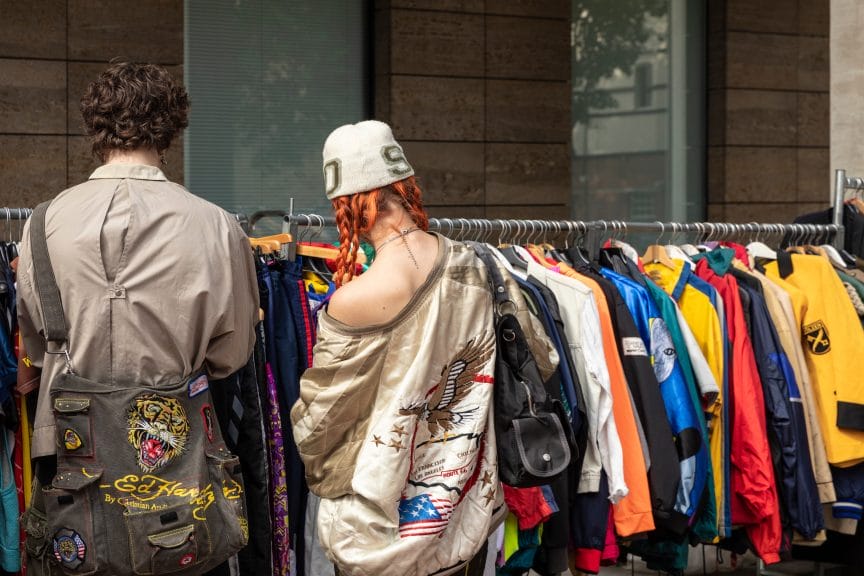“I’m gonna pop some tags. Only got 20 dollars in my pocket”— which actually won’t get me very far.
Macklemore’s 2012 hit “Thrift Shop” revels in the thrill of stretching $20 to its limits when second-hand shopping, celebrating the bounty of affordable treasures waiting to be found. Yet, in today’s reality, the sentiment feels more like a distant memory.
In a world where thrift shopping has morphed from a budget-friendly haven into a realm overtaken by resellers, that $20 might only afford you a single sweater— if you’re lucky.
I guess “I paid 8.49 for this cotton t-shirt” doesn’t have quite the same ring to it?
Originally an affordable resource for low-income individuals during times of economic hardship, thrift shopping offered access to essential items at significantly lower prices.
Since its growth in popularity, the landscape of thrift shopping has shifted dramatically, with prices skyrocketing and affordability diminishing.
Thrift stores, once a dependable sanctuary for sustainability and frugality, have faded into a playground for resellers and thrift flippers alike.
Prices going up
In an era of microtrends, everything is coined as an aesthetic. This isn’t a sweater, it’s an homage to “eclectic grandpa,” and this tank top is soo “heroin chic” right?
Thrifting itself has become an aesthetic.
Who’s capitalizing on this phenomenon? Who has the means to capitalize on this?
The cycle is never-ending. An aesthetic goes viral, fast fashion companies mass produce thousands of cheaply made garments, the trend dies, and fashionistas everywhere dispose of their pieces faster than you can say SheIn.
The more we buy the more we donate.
A 2019 New York Times article revealed that much of Gen Z admits to only wearing their purchases once or twice. I mean, what’s the point of keeping a piece you already posted on your Instagram feed?
This rapid turnover of trendy pieces and the commodification of aesthetics is clear under the fluorescent lights of any thrift store— especially when you see the price tag.
Pieces are selling more second-hand than they did a week prior at the mall.
So often influencers urge their followers to “run, don’t walk” to thrift stores to find emerging trends, but what do they find instead? SheIn. Many of these unsustainable pieces, priced $6 new on the website, are tagged $6.49 at the thrift store, where they linger for months. This only continues their cycle of unsustainability.
Many creators push the act of “saving SheIn” from thrift stores, and giving it a chance at life, but are the consumers meant to front the responsibility? How long will this cycle persist? And what if you don’t have the 49 cents to spare?
Baby tee or baby’s tee?
These problems persist if the items make it to the thrift store floor, but often, they do not.
You thought a Disneyland rope drop was crazy? Just imagine the Glendale Goodwill bins at 8 AM on a Saturday.
In this current age of resale, people have seized the opportunity to make a profit. We see this in concert tickets, where resellers hike up an $80 price tag to $280 the second Ticketmaster marks them sold out, and we see it in our “thrifted” clothing.
As thrifting has surged in popularity, so too have online resellers.
Enter Depop: the cool girl’s go-to shopping app for buying and selling second-hand clothing and accessories.
As explained on Depop’s “Who We Are” page, sellers “are entrepreneurs, pushing fashion forward in so many different ways” but all the platform seems to push forward is exclusivity. Their page repeats, again and again, this idea of community, but aren’t they pushing one to extinction?
Depop focuses on curation, encouraging sellers to build vintage resale businesses. This directly challenges the traditional ethos of thrift shopping, which emphasizes affordability and accessibility.
This emphasis on entrepreneurship pushes the everyday person to prioritize a quick buck over an ethical sale.
The “inventory” of these Depop sellers has become a running joke online, as users share the ridiculous nature of the app’s listings. Children’s t-shirts are marketed as “baby tees—” which is a creative use of marketing, to say the least.
Isn’t an XXS just a 4T?
These resellers have infected the thrift stores, buying vintage items in bulk.
In the Reddit thread r/Flipping, one user writes “My strategy is to sell anything and everything.” This seems to be common practice.
In reducing accessibility for those who rely on thrift shopping as a resource, these “entrepreneurs” look for labels. People aren’t buying what looks good on them or what’s missing from their closet, they’re buying what will turn a profit.
My mom shouldn’t be searching the resell value of a Betsey Johnson purse, and a 15-year-old customer shouldn’t be wearing my same uniform that she “found at Savers” and ‘thinks is so cute.”
“Look at all this excess fabric!”
As influencers rise, so do thrift hauls. Short-form or long-form content, YouTubers and TikTokers alike push and shove for the haul.
For many content creators, a successful haul means a hefty paycheck. Emma Chamberlain’s 2020 “MASSIVE THRIFT HAUL” garnered nearly 6 million views, and videos like “Thrifting Spring Fashion” or “Thrifting 2024 Trends” emphasize the content-driven nature of these shopping sprees. These hauls have become their livelihood.
While these videos do promote sustainable in-store shopping, they also promote overconsumption. I doubt this fashion YouTuber has a gap wide enough in her wardrobe that only a “massive thrift haul” could bridge, but perhaps she did need another black maxi skirt!
Sustainability unfortunately goes out the window when you become a “collector.”
Ever tried asking an influencer where the shirt in their video is from? Good luck hearing anything other than “thrifted <3” back (they bought it for $250 on The RealReal).
Akin to the “Thrift Haul” is the “Thrift Flip.” Creators DIY fashion-forward looks using “old” clothes from the thrift store.
Rather than buying clothes that fit, these “flippers” size up, using the inches and inches of excess fabric for their intricate design. Extra points if your size 42 men’s jeans are Levi’s brand— that’ll get more traction online.
Often these flips are resold online, tagged as “custom,” and disguised to trick buyers into purchasing. They also strip larger-bodied individuals of quality brands and pieces.
As is, thrift stores have limited plus-size selections. The reality is that the vast majority of brands don’t produce clothes larger than size XL and vintage clothing runs notoriously small. As a result, only a fraction of these already limited pieces end up in thrift stores, and when a piece is good, plus-size people hold on to it.
To put it simply, it’s hard to find plus-size clothes, and it’s becoming even harder to afford them.
To thrift or not to thrift?
Certainly, the blame can’t all fall on the individuals reselling clothing. Thrift corporations are largely at the forefront of the problem. Depop is the one promoting entrepreneurship, and your local Savers just hiked their prices… again.
These corporations prioritize profit margins over their core demographic—frequent thrifters who rely on these stores out of necessity. These individuals may be able to bypass reselling, but they can’t avoid the thrift store itself, where inflated prices prevent access to essential goods.
Did thrifted clothing trade the “dirty” name tag for “well-loved” when Bella Hadid was spotted at a New York consignment store? When people could afford to shop at these stores, 10 or so years ago, shame was tagged on the item free of charge!
Will thrift stores ever reclaim their mission of accessibility, or has our culture shifted completely?
And what’s left in the thrift store? Pit-stained H&M tank tops and deteriorating Air Force 1’s? Macklemore wasn’t kidding when he said “This is f****** awesome.”















Tam
March 27, 2024 at 6:29 pm
So real!!!! Such a thought provoking must read!!!!